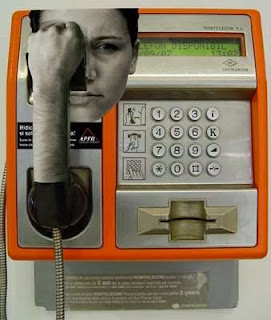When it works:
Using shockvertising is a great way for activist organizations to get their message across to a large audience. Many organizations ranging from drug abuse to animal abuse or human rights use shocking ads to capture people's attention and bring light to their cause. In their case they force the audience to think about the message, making a lasting impression on them.
Graphic Anti-Whaling Campaign
Battered Women Ad
'Humans for Animals' Graphic Anti Sea Clubbing Ad
In the case of these ad campaigns, shockvertising works very well. These organizations are trying to invoke an emotional response from the audience by using graphic and thought provoking scenarios. Their way of getting a message across is effective to the point that they may not make their brand recognizable but they are able to create an impression on people's minds about what their organization stand for or against, which si their ultimate goal.
When it kind of works:
Some brands will use shockvertising to sell a product. Usually that involves nudity (the case of most high fashion ads) or sexual references. Usually shockvertising in these ads aren't as graphic, but more so controversial. These ads try to bring out an emotional response as well, but in most cases its a negative or "oh my god did they actually do that!?" kind of response. And in most cases of high fashion ads its perfectly ok with the brands to be seen as negatively or controversial. They're trying to look edgy and cool and sexy, so these ad campaigns often involve shock material that relates to sex.
Terry Richardson Watch Campaign
Tom Ford Eyewear Ads
Belvedere Vodka Ad
In these cases they're using sexually explicit material to sell their product. They're associating their brands with sex and fun and being edgy. This is the look they want their brands to represent, and the market they're targetting has an appeal for this, so it works out.
When they kind of miss the point. Sometimes completely:
Sometimes you see ads that use shockvertising but they completely confuse the audience into going "what am I even looking at? what the f*** is this? are they stupid?". Some brands take a chance with shockvertising and miss their mark completely, sometimes resulting in their brands being put in a negative light. This is when they really should have done some market research and got someone to re-evaluate their ad campaigns.
I'm not sure what they're trying to sell but there's insects all over the place and ew.
Magazine cover. Just why. How is this relevant to anything? I don't understand!?
Next time when you're trying to sell accesories, try not alienating 50% of your audience by portraying women as shoe racks.
Also try not using a reference to AIDS when selling handbags. Not only is it completely irrelevant, its also kinda offensive because thats sensitive subject material.
So basically, shockvertising to me is an effective advertising medium as long as it is relevant to your brand or company and doesn't effect it negatively (unless you want to be seen as the "controversial" brand). I understand that all publicity is good publicity, but if I see an ad for handbags that says "we're all potential carriers" i'm more likely to assume i'm getting AIDS from your handbags than anything else. Keep it simple, keep it relevant, and make an effective use of this creative advertising category.










No comments:
Post a Comment